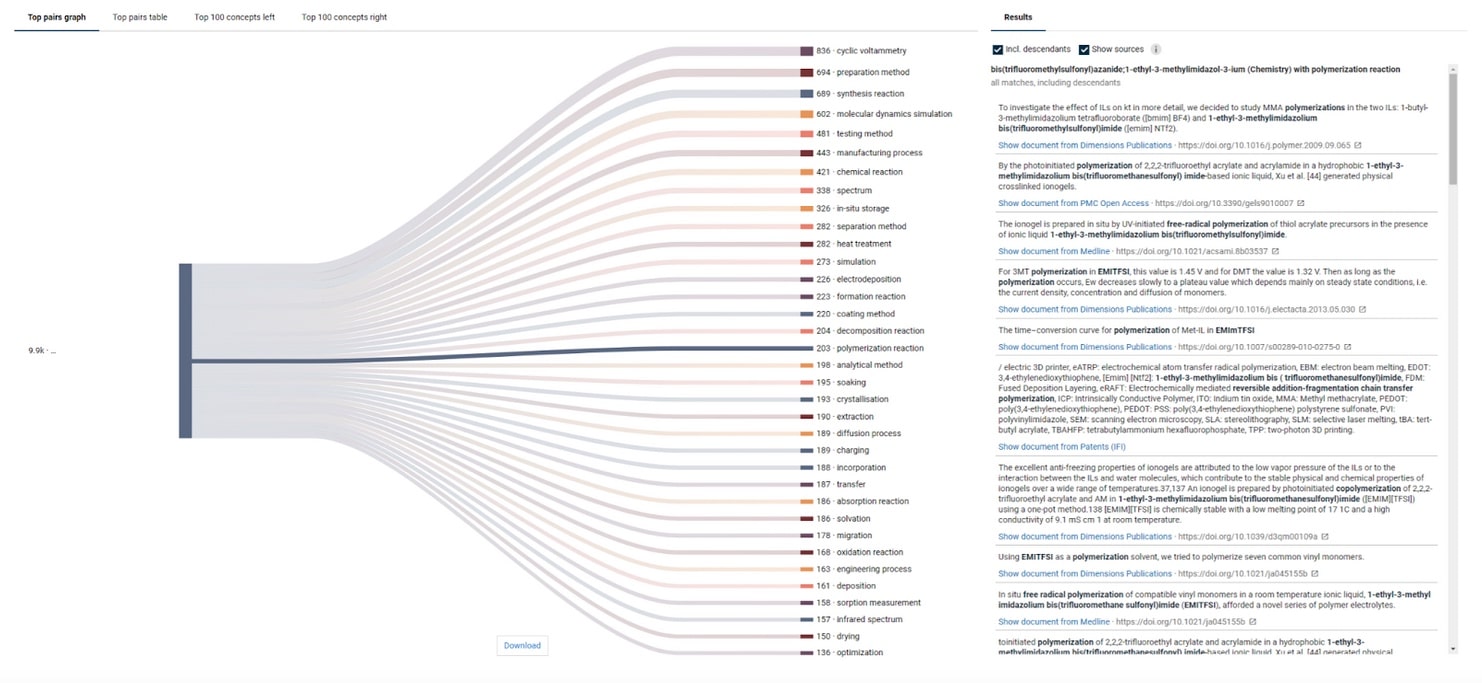
Chemistry has transformed to focus on sustainable “green” processes that minimize hazardous substances through efficient, cost-effective and environmentally benign design. Ionic liquids (ILs) have emerged as an extremely promising tunable, non-flammable, low volatility solvent. ILs’ modular structure of paired anions and cations allows precise property optimization to enhance reactions and enable recycling while reducing waste. However, selecting the optimal ion combination is complex given the vast number of possibilities. This requires consolidating knowledge fragments scattered across documents and fields to determine ideal selections. Powerful computational tools are critical to search databases, uncover hidden connections and guide innovation towards the most fruitful, sustainable IL applications.
SciWalker

Powerful tools like SciWalker search through scientific and patent databases for annotated content to uncover hidden connections between IL ion pairs and concepts like properties or applications. By bringing together these fragmented insights, SciWalker guides innovation towards the most sustainable IL designs, enabling the transition to green chemistry.
SciWalker is part of OntoChem’s suite of chemical and life science tools. It provides easy access to Dimensions, the largest linked databases of over 140 million annotated scientific documents and 150 million patents. Annotations leverage extensively developed ontology cartridges covering chemical, biological and other concepts, recently updated. Ontologies hierarchically organize terms, flexibly recognizing concepts via attributes like structures, names, identifiers, and properties for chemical compounds.
The case of [NTf2]- and alkyl-imidazolium cations
Identifying the compounds
Let’s use [NTf2]- (short for Bis(trifluoromethanesulfon)imide) and [DMIM]+ to demonstrate the capabilities of SciWalker to merge fragmented scientific and industrial literature. The two ions can be searched in the Domain explorer using an ontological tree or in the Chemistry Search by drawing it.
![Figure 3. [Left] Searching for [NTf2]- anion as a concept, in the ontological tree
[Right] Structure drawing of components: [DMIM]+ (the simplest form of an alkyl-imidazolium cation).](https://www.digital-science.com/wp-content/uploads/2024/01/sciwalker-figure-3.jpg)
After drawing the chemical compound, we can search for all the substructures containing the basic skeleton of [DMIM]+. We obtained 226 results. Additionally, we can see how many times each ion combination is mentioned across patents and publications. Patent statistics are further categorized by occurrences in full text versus claims sections specifically. Higher mentions can indicate commercial popularity, as for the widely used ionic liquid EMIM-TFSI. Meanwhile, rarely referenced variants may represent opportunities for new intellectual property protection and expanded patent portfolios.
![Figure 4. Result examples when searching for combinations of [NTf2]- and substructures of [DMIM]+.](https://www.digital-science.com/wp-content/uploads/2024/01/sciwalker-figure-4.jpg)
Analyses
Once identified, two possible analyses are available: either drilling down into any compound for associated documents, synonyms, identifiers, properties, and parent classes; or using the co-occurrence analysis. This visually maps relationships with other concepts like experimental methods. For the ionic liquid EMIM-TFSI, this reveals techniques analyzing it as an electrolyte. The versatile co-occurrence tool applies across niche or general domains.

SciWalker – Connecting Knowledge Fragments

SciWalker integrates fragmented insights across documents and fields to inform decisions. As we have seen, the platform consolidates dispersed knowledge, bridging interdisciplinary gaps to reveal broader perspectives.
In our [NTf2]- example, SciWalker streamlined exploring Ionic Liquid mixtures. The intuitive visual search of our extensive databases and ontology cartridges simplifies finding optimal ion pairs. Users can discover new compounds starting from a basic structure and investigate how additional chemical fragments influence their utility.
Co-occurrence mappings also expose relationships with external concepts like applications or methods. This system-level visibility assists holistic understanding and discovering new sustainable chemical processes.
By intersecting knowledge fragments into an interconnected landscape, SciWalker enables targeted innovation. Unified insights guide users through multifaceted chemical research challenges.
To find out more about SciWalker, visit the OntoChem website.






























